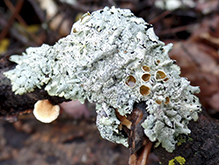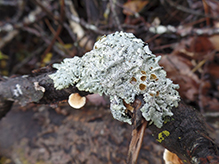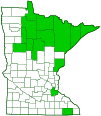American Starburst Lichen
(Imshaugia placorodia)
Conservation • Description • Ecology • Distribution • Taxonomy
Conservation Status |
|
|||||||
| IUCN Red List | not listed |
|||||||
| NatureServe | NNR - Unranked |
|||||||
| Minnesota | not listed |
|||||||
Description |
||
American Starburst Lichen is found in the United States from Maine to Minnesota and south along the foothills of the Appalachian Mountains, in the northern Great Plains, the central and southern Rocky Mountains, and the southern Intermountain Region in the southwest. It grows on the bark of pine trees. It is almost restricted to pitch pine, jack pine, and Virginia pine in the east, and to ponderosa pine and Douglas fir in the west. It is rarely found on oak. In Minnesota it is found only on jack pine. The vegetative body (thallus) is leaf-like (foliose) and divided into branches (lobes). It grows attached or loosely attached to the substrate (bark) by scattered, short, brown, anchoring structures (rhizines). The lobes are narrow, strap-shaped to rounded, and 1 ⁄64″ to 1 ⁄16″ (0.5 to 1.5 mm) in diameter. They are more or less randomly arranged and touch, crowd, or overlap adjacent lobes but are not fused to them. The margins are wavy or deeply pinnately cut, and the tips are often forked. The upper surface is grayish-green or ash-colored, smooth and somewhat shiny toward the edges, and wrinkled toward the center. There are usually tiny, globular chambers (pycnidia) embedded in the thallus with an opening through which fungal spores are released. The pycnidia look like black pinpricks in the tallus and are very conspicuous. They appear both on the margins and across the surface. The upper surface does not have powdery dull granules (soredia), shiny granules (isidia), or a chalky or “frosted” surface (pruina). The lower surface is whitish to pale brown, shiny, and somewhat wrinkled. Disk-like, spore-producing structures (apothecia) are usually present, sometimes abundant enough to conceal the thallus. The disks are slightly raised, shaped like a plate, concave to flat or even convex, 1 ⁄16″ to ¼″ (2 to 7 mm) or more in diameter, pale brown or chestnut brown to dark grayish-brown. They may be flat or slightly raised, and stalkless or very short stalked. They appear near the margins on the upper surface. |
||
Similar Species |
||
Ecology |
||
Substrate |
||
Trees |
||
Growth Form |
||
Foliose |
||
Habitat |
||
|
||
Hosts |
||
Jack pine |
||
Distribution |
||||
|
Sources |
|||
| 5/29/2022 | ||||
Occurrence |
||||
Widespread in North America. Common in northeastern Minnesota. |
||||
Taxonomy |
|||
| Kingdom | Fungi (Fungi) | ||
| Subkingdom | Dikarya | ||
| Phylum | Ascomycota (Sac Fungi) | ||
| Subphylum | Pezizomycotina (Sac Fungi and Lichens) | ||
| Class | Lecanoromycetes (Common Lichens) | ||
| Subclass | Lecanoromycetidae (Shield Lichens, Sunburst Lichens, Rosette Lichens, and Allies) | ||
Order |
Lecanorales (shield lichens, rim lichens, and allies) | ||
Suborder |
Lecanorineae | ||
Family |
Parmeliaceae (shield lichens and allies) | ||
| Subfamily | Parmelioideae (typical shield lichens) | ||
Genus |
Imshaugia | ||
| Mycobiont | Imshaugia placorodia | ||
| Photobiont | |||
Synonyms |
|||
Parmeliopsis placorodia |
|||
Common Names |
|||
American Starburst Lichen |
|||
Glossary
Apothecium
An open, disk-shaped or cup-shaped, reproductive structure, with spore sacs on the upper surface, that produces spores for the fungal partner of a lichen. Plural: apothecia.
Foliose
Adjective: Leaf-like growth form; referring to lichens with leaf-like growths divided into lobes.
Noun: The leaf-like, vegetative body of a lichen (thallus) that has thin, flat lobes which are free from the substrate.
Pruina
On lichens, a thin, powdery or crystaline deposit on the surface of the thalus. It may appear chalky or frosty, and is usually white, gray, or bluish.
Rhizine
A root-like structure of a lichen that attaches the lower layer to the substrate.
Soredium
An asexual reproductive structure of a lichen in the form of a tiny dull granule on the thallus surface that can be easily brushed off. It consists of a cluster of algal cells (the photobiont) wrapped in fungal filaments (the mycobiont), but without an outer layer of protective tissue (cortex). Plural: soredia.
Thallus
The vegetative body of a lichen composed of both the alga and the fungus.
Visitor Photos |
|||||
Share your photo of this fungus. |
|||||
| This button not working for you? Simply email us at info@MinnesotaSeasons.com. Attach one or more photos and, if you like, a caption. |
|||||
Luciearl |
|||||
 |
 |
||||
MinnesotaSeasons.com Photos |
|||||
|
|||||

Slideshows |
||

Visitor Videos |
|||
Share your video of this fungus. |
|||
| This button not working for you? Simply email us at info@MinnesotaSeasons.com. Attach a video, a YouTube link, or a cloud storage link. |
|||
Other Videos |
|||

Created: 10/31/2018
Last Updated:


